Articulate
7 Articulate Examples That Inspire Creativity in Online Courses
Creating engaging online courses is an art. It requires creativity, innovation, and the right tools....
Read MoreEven before Covid-19 took the world by storm, the World Health Organization (WHO) knew e-learning for health was important. In a 2013 study WHO claimed that more available e-learning for healthcare was to be a major focus. Another WHO study on e-learning for health showed that online learning provides superior outcomes over in-person training.
Then came Covid-19. Placing more extreme stress on the healthcare systems of countries around the world. While social distancing also terminated face-to-face training. If e-learning for health wasn’t important already, now its mission-critical for many organizations. This blog post discusses the changes happening with e-learning for healthcare, in part due to Covid-19. Included are practical examples of online learning. As well as, e-learning solutions for health that we’ve created for our healthcare clients. Also, we include online training from organizations supporting and servicing the healthcare industry. Now more than ever e-learning for health is vital. Don’t be left behind. Find out what you can do.You don’t have to be intimately involved in the healthcare sector to appreciate the challenges it is facing. Do a google search on ‘challenges in the healthcare sector’. You’ll receive 678 million results in half a second.
My google search presented documents and literature reviews that amongst other challenges cited
This list is not exhaustive. But its also not unreasonable that more consistent, and scalable training can help to solve these challenges.
Healthcare around the world is grappling with a multitude of challenges. Notwithstanding pandemics such as Covid-19. Also, a part in solving many of the challenges involves a training component. Yet, can e-learning provide a viable, quality learning experience to be a solution?
Various studies over the years have concluded that it definitely can. In 2009 a large meta-analysis by the US Department of Education found that “on average, students in online learning conditions performed better than those receiving face-to-face instruction”. Also, a 2013 study by the Institute of Public Health at the University of Cambridge cited that “In response to these (healthcare) challenges, increasing numbers of medical education and CPD (Continued Professional Development) programs have adopted e-learning approaches, which have been shown to provide flexible, low-cost, user-centred, and easily updated learning.”
“…on average, students in online learning conditions performed better than those receiving face-to-face instruction”
US Department of Education
Shortly afterwards in 2014, the Journal for Global Health published “e-learning for undergraduates in health professions: A systematic review of the impact on knowledge, skills, attitudes and satisfaction”. It reported that there was a worldwide shortage of 7.2 million health-care workers. And that the number is growing. Also, the shortage of teachers is even greater, limiting traditional education modes. They reviewed 4,955 students enrolled in undergraduate healthcare studies. They concluded that “e-learning is equivalent and possibly superior to traditional learning regarding knowledge, skills, attitudes and satisfaction.” Furthermore, they stated these results justify further investment into e-learning to address the global healthcare workforce shortage.
In 2015 the World Health Organization published a review and proposed a radical transformation. It was called e-learning for undergraduate health profession education. They concluded that “e-learning has an under-exploited potential to support health workforce capacity building in different contexts, and can empower health workers to take charge directly of their competency development, to enable them to play a full role as change agents in addressing the challenges we will face in the 21st century.”
“e-learning has an under-exploited potential”
World Health Organization
Currently both the United Nations (UN) and the WHO have endorsed e-learning as a useful tool in addressing education needs in health care. And that was before Covid-19, social distancing, and the challenges presented by this latest coronavirus.
Besides e-learning for health having better outcomes, it also has many extra benefits. These include
Webinars are a solution that many organizations have put in place to deliver aspects of their training. Especially post Covid-19. Webinars are easy to set-up and can connect you to your audience. And it has been shown that webinars can be good for demonstrations, or introductory topics. Or short discussions on a defined topic. For example, webinars can be a good replacement for quick ‘lunch and learn’ kinds of training.
But, for the majority of needs in the healthcare system webinars aren’t a good training solution. Health training topics and needs are often in-depth and complex. Or have critical outcomes if incorrectly applied. Webinars aren’t a suitable training medium for longer courses. Or anything other than for a short introductory component. In particular, they aren’t effective if the learner needs to show proficiency in a topic. Similarly, they are not suitable for situations that are high risk. Or that have high confidentiality or privacy requirements. For many health-related training needs e-learning courses are preferable.
To show the range of e-learning courses in healthcare, below are three actual examples of online courses. They illustrate a few of the practical applications of e-learning for health.
The BC Center for Disease Control (BCCDC) provides health promotion and prevention services, analytical and policy support to government and health authorities. As well as diagnostic and treatment services. All to reduce communicable and chronic disease, preventable injury and environmental health risks.
The BCCDC contracted Spark + Co when they needed an e-learning for health course on vaccine storage and handling.
The purpose of the course was to ensure that vaccines were handled and stored properly throughout the chain of custody. And that all regulatory requirements were adhered to as well as Provincial guidelines. The audiences for the training course are Medical Office Assistants, Health Unit Aides. As well as any other interested immunizer (e.g., Pharmacists, Registered Nurses, Physicians) and health care students.
An e-learning course was created. It consisted of an introduction, three technical chapters, and a final exam. As well, a quick reference guide was also created. This was to support the range of people involved with vaccine storage and handling to ensure the safety and efficacy of vaccines.
The online course was created in Articulate Storyline. It included drag and drop interactions, interactive forms, and an exam.

Screen shots of e-learning activities in the BCCDC course
In 2011 the Kidney Care Advisory team at BC Renal established 4 priorities to improve outcomes for those with kidney disease. One of these priorities was to develop standardized and enhanced educational materials. All based on principles of adult education. Spark + Co. was contracted to design and develop online learning templates. As well as 3 online modules to increase access to education to those with kidney disease in BC.
Peritoneal dialysis is done by patients in a home setting. Previous education of patients consisted solely of nurses visiting a patient. As part of the visit, the nurse would bring a large reference binder. And do some one-on-one consultation. But in rural and remote areas, nurses would have to travel large distances. Thus, limiting the number of patient visits. As well, the winter months created additional travel difficulties.
In urban settings, there were also challenges with access to education. Because of the high patient-load for each nurse. The online modules were designed to supplement the nurse. And to reinforce the patient relationship. They were also created to empower patients to play an active role in their treatment. The online course modules were developed with the primary goals of helping patients understand how peritoneal dialysis works, and to help them live a healthy life.
The online modules were developed in Articulate Studio ’09. A Powerpoint based authoring tool that allows the inclusion of a variety of interactive elements. The modules also included voice-over narration, videos and interactive activities.

Screen shots from the BC Renal Agency e-learning for health course
Interestingly kidney patients living in British Columbia, reportedly have the highest survival rate in Canada.
Child Health BC is a provincial health network consisting of many partners. These include
The goal of Child Health BC is to work together to improve the health status and health outcomes of BC’s children. By building an integrated and accessible system of service. The Steering Committee of this network hired Spark+Co. to develop e-learning for child health.
The Appetite to Play initiative, of Child Health BC, supports Healthy Families BC. A government health prevention and promotion strategy. This focuses on health improvement for families and their communities.
Appetite to Play was developed to enable child care workers to promote and encourage healthy eating. And physical activity, for children 0-5 years old. There were several components
Two e-learning modules were developed on physical literacy, and healthy eating using Articulate Storyline 360. These e-learning modules included many interactive activities such as interactive video quizzes.

Screen shots from Child Care BC course, with interactive video
“I liked the combination of visuals with the text and audio, I think it really helped to highlight the content.” E-learning module participant
Between February 2017 and March 2019, 2,886 people participated in the training (e-learning, virtual and in-person). The final evaluation report concluded that
Kai Ruggeri, Institute of Public Health, University of Cambridge, published a paper in 2013. In it, he proposed a model for effective use and evaluation of e-learning for health. The model, while useful in many situations is best applied to e-learning for large health authorities. The example Ruggeri cited to illustrate his model was for a Program on Clinical Record Forms and Evaluation.
A summary of Ruggeri’s example is below. It shows the rigorous process applied. As well as the interconnected steps for ensuring an effective online course in this sector.
E-learning can also benefit organizations in servicing or supporting healthcare. Below are three examples of e-learning for healthcare for industries supporting the sector.
PeriopSim is a North American product focused on surgical training and assessment for operating room teams. It uses virtual and augmented reality to bridge the gap between the classroom and the operating room. It helps users to learn procedures, anticipate the surgeon and instrumentation required. All before going into the operating room. Research has shown that PeriopSim is more effective than traditional training methods. As well a 1-hour procedure takes only 10 minutes using the simulation. This helps nurses to gain practice time in surgical procedures.
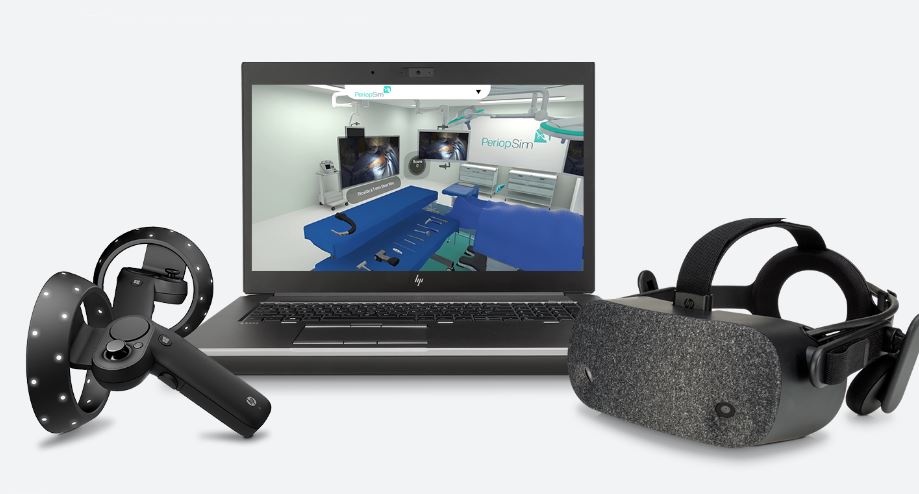
Periopsim Virtual Reality Training
The Resuscitation Council (UK) exists to promote high-quality, scientific, resuscitation guidelines that apply to everybody. And to contribute to saving a life through education, training, research and collaboration. Targeting the general public, one of the best examples of powerful e-learning is from this Council. This interactive film puts you into the shoes of a lifesaver. And provides realistic situations and actions to test your skills and responses in life or death situations. It’s an excellent, award-winning, module of e-learning for health.
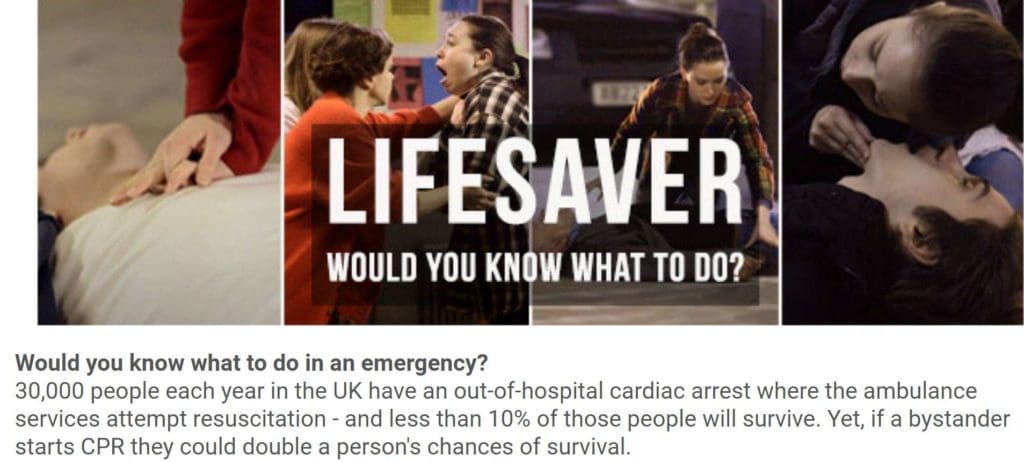
Award winning Lifesaver interactive scenario course
At the time of writing, COVID-19 is still prevalent across the globe. In a short space of time organizations have mobilized to create e-learning for healthcare training on many Covid-19 procedures. Often these resources are available to audiences around the world free of charge. For example, the World Health Organization has created a series of e-learning courses on a variety of Covid-19 topics. These courses are also in a variety of languages. However, due to the urgency, they sometimes lack the level of interactivity that can be created in e-learning courses. The highly interactive Lifesaver example above took 3-years in the making. Yet, the WHO course shows how quickly, effective e-learning for health can be created. And how it can be a powerful tool for quickly communicating to a large, widespread (global) audience.
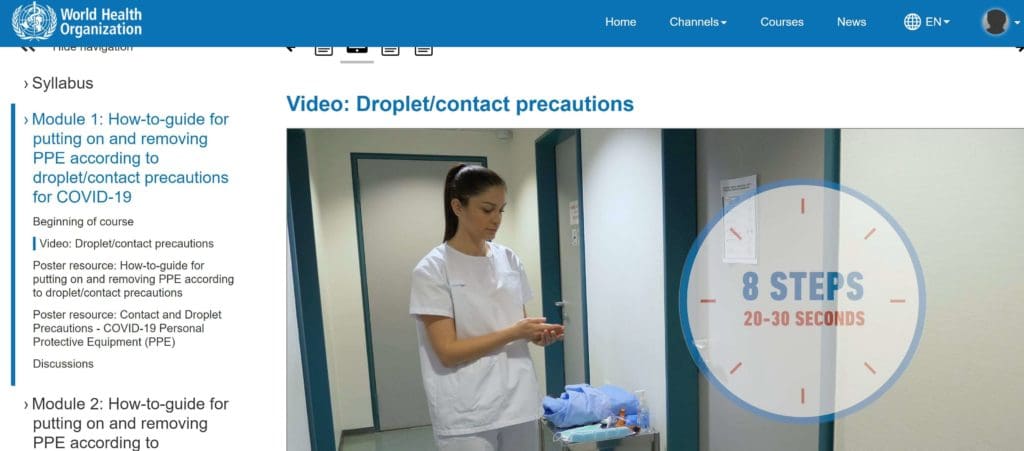
Screen shot of Covid-19 course by the World Health Organization
A second example comes from the NHS in the UK. Following a registration process, anyone around the world can access their online courses and many resources about Covid-19 for free. Both these examples show how e-learning can scale to allow you to train a lot of people in a short period.
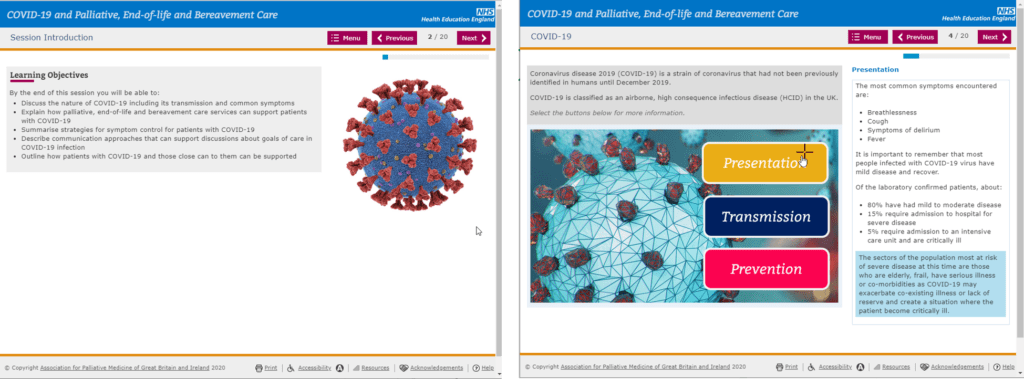
Screen shots from the NHS (UK) course on Covid-19
A third Covid-19 course, COVID-19 What You Need To Know, worth mentioning is one developed by Articulate. Developed in Rise, a rapid e-learning authoring tool that is cloud-based and mobile-friendly. What this means is that you can develop e-learning courses quickly without having to download any software. Rise doesn’t have the sophistication of some tools. But, it excels in simplicity and rapid deployment. In this example, Articulate developed the course, and like the above examples, shares it for free to the world.
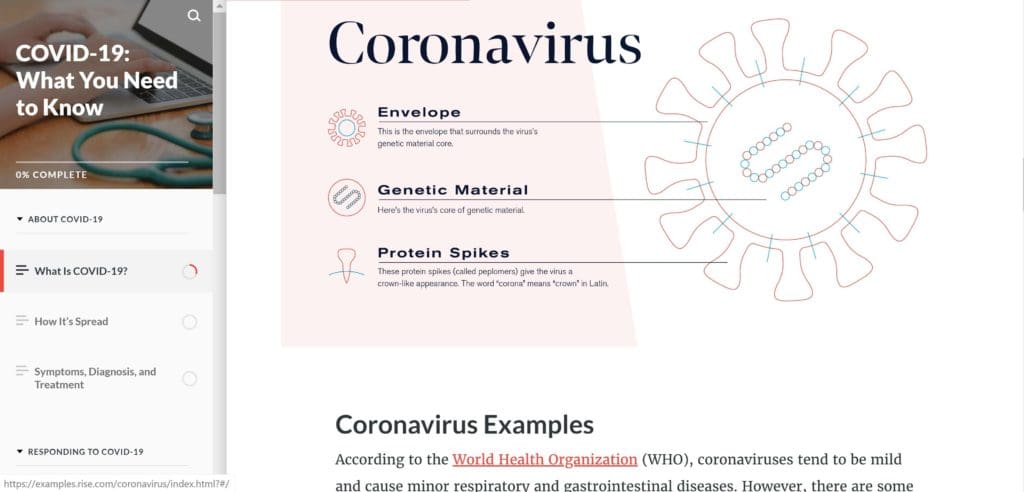
Screen shot of course on Covid-19 by Articulate Rise
In a previous blog post, we described many successful interactive e-learning activities for self-paced learning. Ones that will elevate the quality of an online course. While also improving knowledge transfer to the learner.
These same activities can be used in designing e-learning for healthcare. For a fuller discussion of these, we would refer you to the original article, but they include the following examples.

Screen shot of one of the branched scenarios in Vitalogue

Screen shots from Ryerson University social work course
How do you start creating an e-learning for health course? It depends on the type, scale, resourcing and expertise your organization has in developing online training. For example, if you have resources in a training department who have expertise in creating quality e-learning then they should be your go-to resource. However, we find many organizations that don’t have the available resources. Or they don’t have the expertise required in creating online learning. In both these cases organizations often can’t find people to hire to fill the resource gap in time. Or they don’t want to commit to a long-term resource for a short-term project. Or they’ve never created an e-learning course before and don’t know where to start.
In these situations, it’s clear that an external resource(s) is/are required to undertake the project. Many of our first clients contacted us because they had never created an online course before. Or because previous results were disappointing. And they were looking for extra expertise to better meet their needs. If your organization is in such a situation, we have two resources that might be useful. The first is a series of articles on instructional design companies
The second resource is a 40 Point Cheat Sheet on Developing Online Learning. It accompanies our Dummies Guide to Developing Online Learning.
Even before Covid-19 took the world by storm, health care institutions were grappling with many challenges. For example, already in 2013, the World Health Organization understood that e-learning for health was important. Then came Covid-19. Placing more extreme stress on already strained healthcare systems. While social distancing has prevented in-person training. If e-learning for health wasn’t important already, as you know, now its mission-critical for many organizations.
Also, we’ve demonstrated the quality and breadth of e-learning for healthcare solutions that can be created. Including expensive and Oscar quality training courses (e.g. Lifesaver). And quickly assembled e-learning in a pandemic emergency. As well as thoughtful, engaging, highly effective and affordable e-learning for health solutions. Such as Appetite to Play, Vaccine Storage and Handling, and Peritoneal Dialysis training for patients. Understanding the range of options will help you begin your organization’s next e-learning journey.
We hope this article managed to ‘Spark Your Interest”. If so please share it with your network, we’d appreciate it. Also if you have specific questions about anything in the article, or if you have suggestions for additions or future articles please don’t hesitate to contact us at info@sparkandco.ca, 250-537-9461.